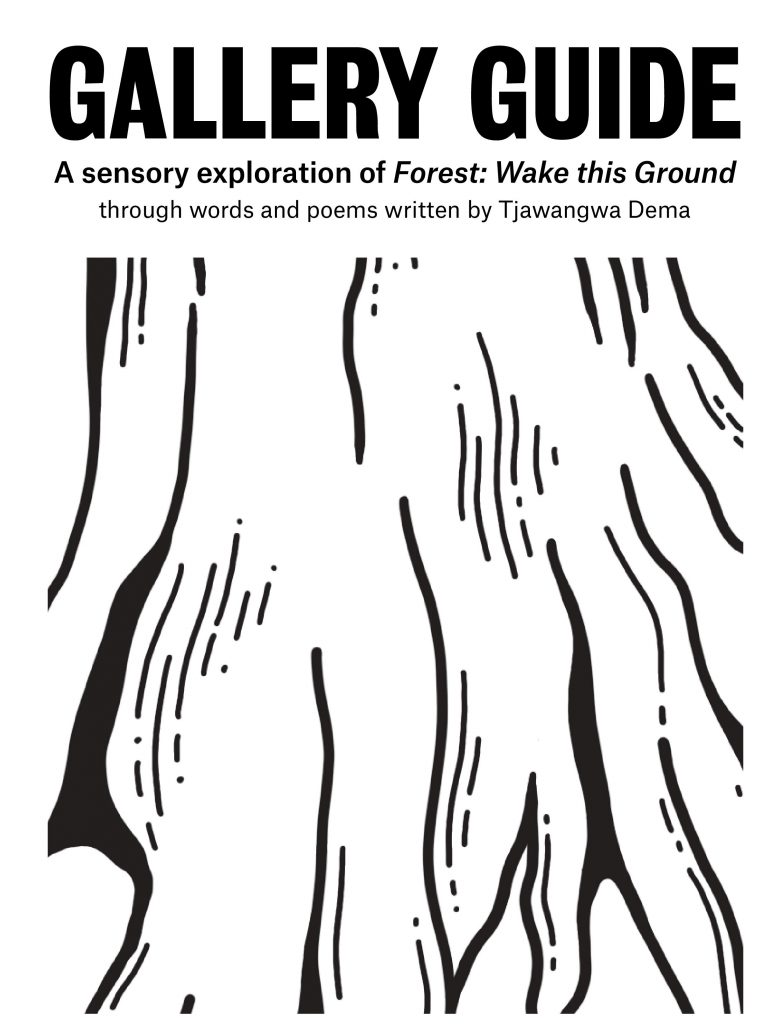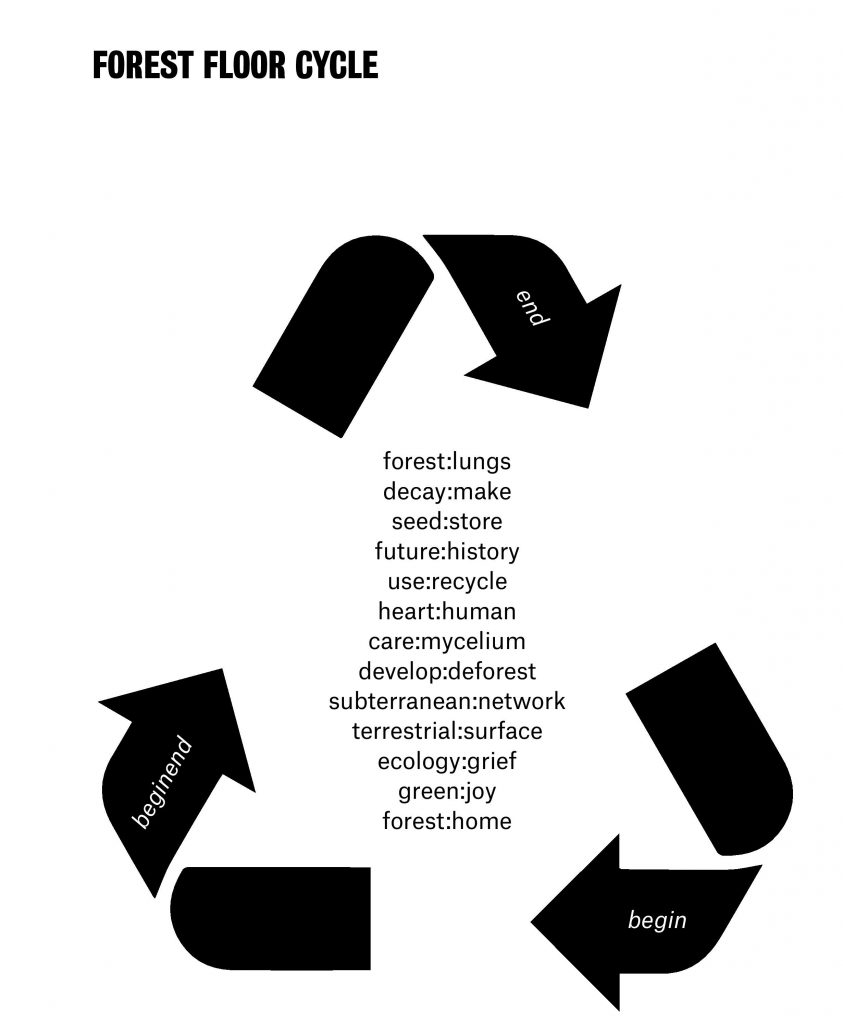Join us for a sensory exploration of Forest: Wake this Ground through words and poems written by Tjawangwa Dema.
Like the forest floor, which is alive with both the seen and unseen, with sights and sounds, this exhibition is both visual and auditory. We hope you immerse yourself in the deliciously varied materiality of soil and cardboard, ceramic and charcoal, amongst other more entangled forms, but remember too to pay attention to all your senses and to listen out for the sounds of the forest.
There is no right or wrong way to engage with this collection of objects and sounds and we encourage you to take your time and to sit with the work.
We live in a time of both infowhelm and uncertainty.
We find ourselves considering the ways in which art and history, power and nature, as well as science and beauty are entangled. Artists are no different; they respond to cultural, socio-political, global and personal preoccupations and in turn place an ‘object’ – which may be a bead or a branch of a tree – in the would-be rift between our understanding of the world and our desire to know more.
Relying on their relationships with their chosen medium and materials, artists offer us ideas to prompt our thoughts or to see things differently. From Brazil to China, local and international artists of our time offer us new and old ways to think about the forest.
You may notice that some of the walls are painted green.
Take a moment to absorb the colour. Green often relaxes us, it can help lower blood pressure and reawaken our brains.
If you were able to leisurely walk or cycle to the exhibition we hope you appreciate the ways in which your body is more attuned to the abundance of this space. We hope you find this ground as alive and moving as we have.
HOW TO BE HERE:
1. You are here. So, welcome. Be here. Be present.
2. You are your own map. What marks the spot is your willingness to see or hear. Reinterpret and reimagine everything you see by relying on your own senses.
3. The word stanza, as in a stanza of poetry or musical stanza, comes from the Italian word for ‘stopping-place or room’. You are in this room. You are now part of its song. Part of its quiet howl and poem.
4. One way of carefully noticing something is by resting your eyes on it. Pick any one work in the room, stand in front of it, facing the object. What do you see? Now stop moving for a moment, feel your body relax, breathe slowly and deeply in through your nose and out your mouth. Repeat while you listen to the sounds in the room.
Can you identify them without turning your head to look? Now block them out as much as possible while looking at the work.
Take your time. Look at different parts, resting your eyes on each part before moving on to the next.
Now take a step back and look at it as a whole. What do you see? Can you try this same experiment but this time relying on your hearing by listening to Hildegard Westerkamp’s Beneath
the Forest Floor (1992). Or test your sense of smell with John Newling’s The Night Books, burning forest (2020-2022).
5. Move slowly in the gallery and be mindful of each other and the artwork which might be more fragile than you think. But do not worry about moving in a straight line or particular pattern. Move closer or sideways or further away. Entangle your path carefully with a stranger’s (without crowding the work or your fellow visitors). Stop and then start again.
Remember ‘nature abhors a straight line’*, so wander at will; the rest is up to you!
6. But if you like rules, here are a few. Follow what is wide and what is narrow. Follow slowness or the heart’s quick beat. Follow what is clean or smeared. Follow stopping and moving. Follow listening and silence. Follow light and darkness. Follow sound – your heart’s or the room’s. You are part of its song now. If a film is playing, follow sitting or standing. Follow questioning and noticing. Be sure to always follow uncertainty and curiosity. Follow yourself; the only trajectory to seeing is the invisible trace your footprints are making now. There is no wrong path here.
7. At your journeys end today, if it is rest you’re after, we have a relaxation room to read, sit and think in. If you are on the ground or first floor follow the stairs or take the lift to find our ‘Forest Rest Space’. We have materials available if you find yourself inspired to write a quick note for yourself, or us, or wish to draft your own verse. You are welcome to spend as much time here as you wish.
Part of what stirs any space to life is a meeting with the other.
Thank you for helping us ‘wake this ground’.
Look at the floor, at your feet – say thank you for coming.
We thank you for coming. Please come again.
* Quote ascribed to William Kent in Derek Clifford’s A History of Garden Design, New York: Frederick A. Praeger, 1967.
Tjawangwa Dema is a writer, arts administrator, teaching artist, and an Honorary Senior Research Associate in the Department of English at the University of Bristol.
Her chapbook Mandible (Slapering Hol Press, 2014) was selected for publication by The African Poetry Book Fund as part of its inaugural New-Generation African Poets Box Set series. Her book The Careless Seamstress (University of Newbraska Press, 2019) won the Sillerman First Book
Prize for African Poets. An ecopoetry chapbook with an accompanying digital archive, an/other pastoral (No Bindings, 2022) explores ethnicity and the environment. To find out more
please visit www.tjdema.com
You can listen to an audio recording of this guide by using the QR code. You can download a copy of the guide at the link above.
This Gallery Guide was commissioned by Arnolfini for Forest: Wake this Ground, 9 July to 2 October 2022. The exhibition includes work by the following artists:
Rodrigo Arteaga, Mark Garry, Alma Heikkilä, Eva Jospin, Jumana Manna, Zakiya McKenzie, David Nash, Maria Nepomuceno, Rosa Nguyen, John Newling, Ben Rivers, Ai Weiwei and Hildegard Westerkamp.
Printed: Earthbound Press
Designed: B Squared Studio










